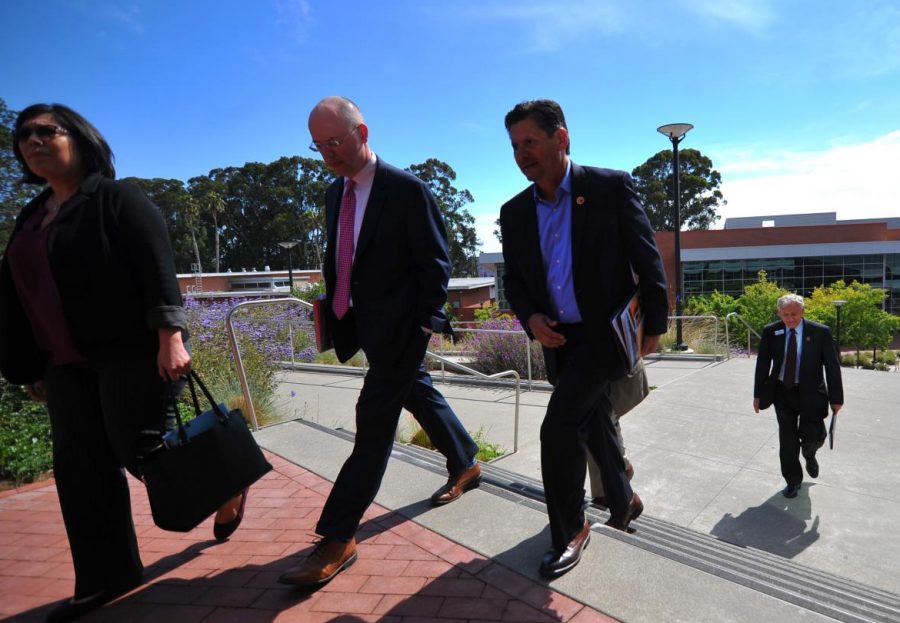State Chancellor visits
State Chancellor Eloy Ortiz Oakley (middle left) walks to the GE Building with his staff after meeting with CCC faculty in Fireside Hall during his visit Monday.
May 15, 2019
A full day of state Chancellor Eloy Ortiz Oakley listening to student, faculty and administrative concerns culminated in a town hall meeting on Monday in GE-225 with an room full of people from throughout the Contra Costa Community College District.
As a part of his “listening tour,” which began in the fall 2018, Oakley has been visiting with faculty, staff and students at seven community colleges up and down the state in an effort to invoke deeper discussions about his Vision for Success and hear concerns that are unique to each college and district.
Oakley’s arrival on campus comes amid a whirlwind of discontent concerning his Vision for Success and new performance-based funding formula — which has drawn criticism from district
Chancellor Fred Wood and United Faculty President Jeffery Michels, among various other groups in the state.
Oakley has also visited Imperial Valley College, East Los Angeles College, Fresno City College, State Center Community College and Sacramento City College
The Vision for Success initiative’s stated goals, which Oakley reiterated during his opening remarks, are to increase the number of degrees and certificates received by the state’s community college students by 20 percent, increase transfers to UCs and CSUs by 35 percent, increase employment for career technical education students and reduce regional and equity gaps — all by 2022.
College President Katrina VanderWoude said several months ago Contra Costa College was chosen by the Chancellor’s Office for the listening tour, which the college accepted.
Oakley’s day on campus included 45-minute meetings with students, classified staff, faculty and the Governing Board.
It also included a mid-day lunch at Aqua Terra Grill.
“This is a way of learning more about what is going on in our community and at our college,” VanderWoude said.
On Monday morning, the Board of Governors for the Faculty Association of California Community Colleges (FACCC) announced a vote of no confidence on Oakley’s office.
This vote comes with the continued opposition to the new performance funding formula.
Michels said, “We’re dealing with a funding formula and the so-called Vision for Success, that was really constructed without much dialogue. Instead, they came up with something that they could push through politically and now are scrambling to defend and modify. The funding formula is a mistake.”
The controversial formula moves away from funding based solely on enrollment numbers to a system where 70 percent of the budget is funded through Full-Time Equivalent Students (FTES), 20 percent is based on low-income enrollment and 10 percent is based on the “student success initiative,” which will increase to 20 percent in three years.
On Monday at the town hall meeting, Oakley opened the floor for inquiries. Several faculty members asked questions giving him the chance to speak to faculty concerns — no students asked questions during this time.
Veterans Services Coordinator TeJae Dunnivant raised concern about students facing challenges outside of the classroom with financial aid and admissions, which affects their learning outcomes.
He also questioned the college’s ability to meet the required numbers under the “Vision for Success.”
“At the end of the day, when a student runs into a roadblock a student runs into a roadblock,” Dunnivant said.
Oakley addressed the challenges of creating guidelines in an academic environment like Contra Costa College and community college’s in general, where students all have different goals.
He reminded the audience in attendance that community colleges serve all students and not just the one’s most prepared.
“It’s our job in the Chancellor’s Office to help colleges have conversations and the programs necessary to serve students. You can’t determine what the roadblocks are unless you ask how they are affecting different types of students,” Oakley said.
Another major concern was brought to the forefront of discussion by Nursing Program Director Sandra Castillo.
She talked about the difficulties nursing programs statewide are facing with hiring.
Nursing students fresh out of college are opting to begin working rather than wanting to be instructors due to the large pay disparity.
According to the Bureau of Labor Statistics nursing instructors and teachers at a junior college earn a mean annual wage of $74,450 compared to $110,030 for nurse practitioners.
Oakley said the disparity sparks conversations into differential funding as a nursing course has higher program costs compared to something like English, especially when it comes to the cost of equipment, necessary student-to-faculty ratios and salaries.
Academic Senate President Beth Goehring said, “We need to have higher pay to attract nursing faculty. But you can’t just increase nursing pay. You’d have to increase faculty pay across the board.”



